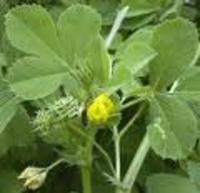
Medicago

Why develop medicago genomics?
The Medicago genus contains 83 species, including the agriculturally important alfalfa (M. sativa), and is distributed mainly around the Mediterranean basin. Comprehensive descriptions of the genus are Lesinš and Lesinš 1979 and Small and Jomphe 1989. Major collections are SARDI (Australia), USDA-GRIN (USA), ICARDA (Syria). Several molecular phylogenies containing most of the species are available, although they differ.
For the cows feed, Medicago is transformed into granules and is a food supplement for the winter. Alfalfa has deep roots. This plant consumes less water than corn.
The species Medicago truncatula is a model legume due to its relatively small stature, genome (450–500Mb), short generation time (~3 months) and ability to reproduce both by outcrossing and selfing.
Medicago truncatula is used as a model for studying interactions between root parasitic plants and legumes.
Most members of the family are low, creeping herbs. However, alfalfa grows to a height of 1 meter, and tree medick (M. arborea) is a shrub.
Creation date: 18 Aug 2010
 eZ Publish
eZ PublishPublication supervisor: A-F. Adam-Blondon
Read Credits & General Terms of Use
Read How to cite








